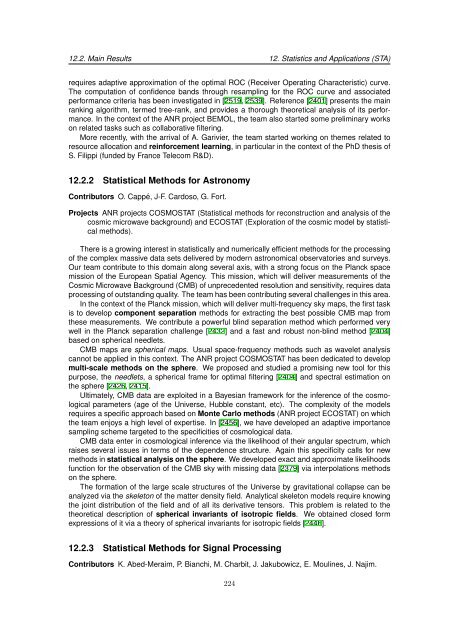TSI report for the period 2005-2009 - Département Traitement du ...
TSI report for the period 2005-2009 - Département Traitement du ...
TSI report for the period 2005-2009 - Département Traitement du ...
Create successful ePaper yourself
Turn your PDF publications into a flip-book with our unique Google optimized e-Paper software.
12.2. Main Results 12. Statistics and Applications (STA)<br />
requires adaptive approximation of <strong>the</strong> optimal ROC (Receiver Operating Characteristic) curve.<br />
The computation of confidence bands through resampling <strong>for</strong> <strong>the</strong> ROC curve and associated<br />
per<strong>for</strong>mance criteria has been investigated in [2519, 2539]. Reference [2401] presents <strong>the</strong> main<br />
ranking algorithm, termed tree-rank, and provides a thorough <strong>the</strong>oretical analysis of its per<strong>for</strong>mance.<br />
In <strong>the</strong> context of <strong>the</strong> ANR project BEMOL, <strong>the</strong> team also started some preliminary works<br />
on related tasks such as collaborative filtering.<br />
More recently, with <strong>the</strong> arrival of A. Garivier, <strong>the</strong> team started working on <strong>the</strong>mes related to<br />
resource allocation and rein<strong>for</strong>cement learning, in particular in <strong>the</strong> context of <strong>the</strong> PhD <strong>the</strong>sis of<br />
S. Filippi (funded by France Telecom R&D).<br />
12.2.2 Statistical Methods <strong>for</strong> Astronomy<br />
Contributors O. Cappé, J-F. Cardoso, G. Fort.<br />
Projects ANR projects COSMOSTAT (Statistical methods <strong>for</strong> reconstruction and analysis of <strong>the</strong><br />
cosmic microwave background) and ECOSTAT (Exploration of <strong>the</strong> cosmic model by statistical<br />
methods).<br />
There is a growing interest in statistically and numerically efficient methods <strong>for</strong> <strong>the</strong> processing<br />
of <strong>the</strong> complex massive data sets delivered by modern astronomical observatories and surveys.<br />
Our team contribute to this domain along several axis, with a strong focus on <strong>the</strong> Planck space<br />
mission of <strong>the</strong> European Spatial Agency. This mission, which will deliver measurements of <strong>the</strong><br />
Cosmic Microwave Background (CMB) of unprecedented resolution and sensitivity, requires data<br />
processing of outstanding quality. The team has been contributing several challenges in this area.<br />
In <strong>the</strong> context of <strong>the</strong> Planck mission, which will deliver multi-frequency sky maps, <strong>the</strong> first task<br />
is to develop component separation methods <strong>for</strong> extracting <strong>the</strong> best possible CMB map from<br />
<strong>the</strong>se measurements. We contribute a powerful blind separation method which per<strong>for</strong>med very<br />
well in <strong>the</strong> Planck separation challenge [2432] and a fast and robust non-blind method [2404]<br />
based on spherical needlets.<br />
CMB maps are spherical maps. Usual space-frequency methods such as wavelet analysis<br />
cannot be applied in this context. The ANR project COSMOSTAT has been dedicated to develop<br />
multi-scale methods on <strong>the</strong> sphere. We proposed and studied a promising new tool <strong>for</strong> this<br />
purpose, <strong>the</strong> needlets, a spherical frame <strong>for</strong> optimal filtering [2404] and spectral estimation on<br />
<strong>the</strong> sphere [2426, 2415].<br />
Ultimately, CMB data are exploited in a Bayesian framework <strong>for</strong> <strong>the</strong> inference of <strong>the</strong> cosmological<br />
parameters (age of <strong>the</strong> Universe, Hubble constant, etc). The complexity of <strong>the</strong> models<br />
requires a specific approach based on Monte Carlo methods (ANR project ECOSTAT) on which<br />
<strong>the</strong> team enjoys a high level of expertise. In [2456], we have developed an adaptive importance<br />
sampling scheme targeted to <strong>the</strong> specificities of cosmological data.<br />
CMB data enter in cosmological inference via <strong>the</strong> likelihood of <strong>the</strong>ir angular spectrum, which<br />
raises several issues in terms of <strong>the</strong> dependence structure. Again this specificity calls <strong>for</strong> new<br />
methods in statistical analysis on <strong>the</strong> sphere. We developed exact and approximate likelihoods<br />
function <strong>for</strong> <strong>the</strong> observation of <strong>the</strong> CMB sky with missing data [2379] via interpolations methods<br />
on <strong>the</strong> sphere.<br />
The <strong>for</strong>mation of <strong>the</strong> large scale structures of <strong>the</strong> Universe by gravitational collapse can be<br />
analyzed via <strong>the</strong> skeleton of <strong>the</strong> matter density field. Analytical skeleton models require knowing<br />
<strong>the</strong> joint distribution of <strong>the</strong> field and of all its derivative tensors. This problem is related to <strong>the</strong><br />
<strong>the</strong>oretical description of spherical invariants of isotropic fields. We obtained closed <strong>for</strong>m<br />
expressions of it via a <strong>the</strong>ory of spherical invariants <strong>for</strong> isotropic fields [2446].<br />
12.2.3 Statistical Methods <strong>for</strong> Signal Processing<br />
Contributors K. Abed-Meraim, P. Bianchi, M. Charbit, J. Jakubowicz, E. Moulines, J. Najim.<br />
224


